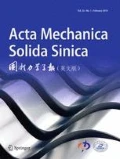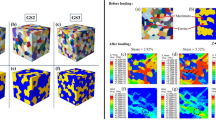Abstract
A plate of dual phase steel was produced from low carbon steel with intercritical annealing treatment. Its optically determined surface microstructure was utilized to construct three different microstructural models. To describe the ductile damage in the ferritic matrix, the Gurson-Tvergaard-Needleman model was used with the failure in the martensite phase being ignored. The numerical results obtained for the mechanism of void initiation and coalescence were compared with the experimental observations. The numerical results obtained from the randomly extruded 3D model showed a significantly better agreement with the experimental ones than those obtained from the 2D model or the uniformly extruded 3D model.
Similar content being viewed by others
References
Furukawa, T., Tanino, M., Morikawa, H. and ENDO, M., Effects of composition and processing factors on the mechanical properties of as-hot-rolled dual-phase steels. Transactions of the Iron and Steel Institute of Japan, 1984, 24(2): 113–121.
Ramazani, A., Mukherjee, K., Prahl, U. and Bleck, W., Modelling the effect of microstructural banding on the flow curve behaviour of dual-phase (DP) steels. Computational Materials Science, 2012, 52(1): 46–54.
Paul, S.K., Real microstructure based micromechanical model to simulate microstructural level deformation behavior and failure initiation in DP 590 steel. Materials & Design, 2013, 44: 397–406.
Kadkhodapour, J., Butz, A. and Ziaei Rad, S., Mechanisms of void formation during tensile testing in a commercial, dual-phase steel. Acta Materialia, 2011, 59(7): 2575–2588.
Ahmad, E., Manzoor, T., Ali, K.L. and Akhter, J., Effect of microvoid formation on the tensile properties of dual-phase steel. Journal of materials engineering and performance, 2000, 9(3): 306–310.
Tasan, C., Hoefnagels, J. and Geers, M., A critical assessment of indentation-based ductile damage quantification. Acta materialia, 2009, 57(17): 4957–4966.
Papaefthymiou, S., Bleck, W., Prahl, U., Acht, C., Sietsma, J. and van der Zwaag, S., Micromechanical damage simulations of TRIP steels. Mater Sci Forum, 2003, 426–432: 1355–1360.
Uthaisangsuk, V., Prahl, U. and Bleck, W., Micromechanical modelling of damage behaviour of multiphase steels. Computational Materials Science, 2008, 43(1): 27–35.
Sun, X., Choi, K.S., Liu, W.N. and Khaleel, M.A., Predicting failure modes and ductility of dual phase steels using plastic strain localization. International Journal of Plasticity, 2009, 25(10): 1888–1909.
Sun, X., Choi, K.S., Soulami, A., Liu, W.N. and Khaleel, M.A., On key factors influencing ductile fractures of dual phase (DP) steels. Materials Science and Engineering: A, 2009, 526(1): 140–149.
Choi, K.S., Liu, W.N., Sun, X. and Khaleel, M.A., Microstructure-based constitutive modeling of TRIP steel: Prediction of ductility and failure modes under different loading conditions, Acta Materialia, 2009, 57(8): 2592–2604.
Uthaisangsuk, V., Prahl, U. and Bleck, W., Failure modeling of multiphase steels using representative volume elements based on real microstructures. Procedia Engineering, 2009, 1(1): 171–176.
West, O., Lian, J., Müstermann, S. and Bleck, W., Numerical determination of the damage parameters of a Dual-phase sheet steel. ISIJ international, 2012, 52(4): 743–752.
Ramazani, A., Mukherjee, K., Quade, H., Prahl, U. and Bleck, W., Correlation between 2D and 3D flow curve modelling of DP steels using a microstructure-based RVE approach. Materials Science and Engineering: A, 2013, 560: 129–139.
Sodjit, S. and Uthaisangsuk, V., Microstructure based prediction of strain hardening behavior of dual phase steels. Materials & Design, 2012, 41: 370–379.
E562-08, A., Standard Test Method for Determining Volume Fraction by Systematic Manual Point Count, 2008.
Lawson, R., Matlock, D. and Krauss, G., The effect of microstructure on the deformation behavior and mechanical properties of a dual-phase steel. In: Fundamentals of Dual-Phase Steels, The Metallurgical Society of AMIE, 1981: 347–381.
Rodriguez, R.M. and Gutiérez, I., Unified formulation to predict the tensile curves of steels with different microstructures. Mater Sci Forum, 2003, 426–432: 4525–4530.
Thomser, C., Prahl, U., Vegter, H. and Bleck, W., Modelling the mechanical properties of multiphase steels, Computer Methods in Materials Science, 2007, 7: 42–46.
Kadkhodapour, J., Butz, A., Ziaei-Rad, S. and Schmauder, S., A micro mechanical study on failure initiation of dual phase steels under tension using single crystal plasticity model. International Journal of Plasticity, 2011, 27(7): 1103–1125.
Gurson, A.L., Continuum theory of ductile rupture by void nucleation and growth: Part I—Yield criteria and flow rules for porous ductile media. Journal of engineering materials and technology, 1977, 99(1): 2–15.
Needleman, A. and Tvergaard, V., An analysis of ductile rupture modes at a crack tip. Journal of the Mechanics and Physics of Solids, 1987, 35(2): 151–183.
Tvergaard, V. and Needleman, A., Analysis of the cup-cone fracture in a round tensile bar. Acta metallurgica, 1984, 32(1): 157–169.
Tvergaard, V., On localization in ductile materials containing spherical voids. International Journal of Fracture, 1982, 18(4): 237–252.
Faleskog, J., Gao, X. and Shih, C.F., Cell model for nonlinear fracture analysis—I. Micromechanics calibration. International Journal of Fracture, 1998, 89(4): 355–373.
Vajragupta, N., Uthaisangsuk, V., Schmaling, B., Müstermann, S., Hartmaier, A. and Bleck, W., A micromechanical damage simulation of dual phase steels using XFEM. Computational Materials Science, 2012, 54: 271–279.
Author information
Authors and Affiliations
Corresponding author
Rights and permissions
About this article
Cite this article
Ayatollahi, M.R., Darabi, A.C., Chamani, H.R. et al. 3D Micromechanical Modeling of Failure and Damage Evolution in Dual Phase Steel Based on a Real 2D Microstructure. Acta Mech. Solida Sin. 29, 95–110 (2016). https://doi.org/10.1016/S0894-9166(16)60009-5
Received:
Revised:
Published:
Issue Date:
DOI: https://doi.org/10.1016/S0894-9166(16)60009-5




